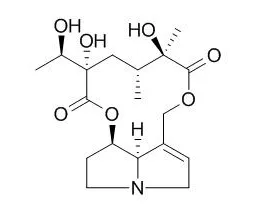| Description: |
Jacoline, jaconine, jacobine, and jacozine, the hepatotoxic alkaloids, are potentially carcinogenic, mutagenic, and teratogenic and may pose health hazards to the human consumer. |
| In vitro: |
| Science. 1977 Feb 4;195(4277):497-9. | | Pyrrolizidine alkaloids: their occurrence in honey from tansy ragwort (Senecio jacobaea L.)[Pubmed: 835011] | | The hepatotoxic alkaloids known to occur in tansy ragwort (Senecio jacobaea L.) are also present in honey produced from the nectar of this species. These alkaloids, which inclued senecionine, seneciphylline, Jacoline, jaconine, jacobine, and jacozine, are potentially carcinogenic, mutagenic, and teratogenic and may pose health hazards to the human consumer. | | J Chem Ecol. 2011 Oct;37(10):1071-80. | | The relationship between structurally different pyrrolizidine alkaloids and western flower thrips resistance in F(2) hybrids of Jacobaea vulgaris and Jacobaea aquatica.[Pubmed: 21969251 ] | The J. aquatica genotype was more susceptible to thrips attack than the J. vulgaris genotype, the two F(1) hybrids were as susceptible as J. aquatica, and susceptibility to WFT differed among F(2) hybrid lines: 69 F(2) lines were equally susceptible compared to J. aquatica, 10 F(2) lines were more susceptible than J. aquatica and 15 F(2) lines were as resistant as J. vulgaris or were intermediate to the two parental genotypes.
METHODS AND RESULTS:
Among 37 individual PAs that were derived from four structural groups (senecionine-, jacobine-, erucifoline- and otosenine-like PAs), the N-oxides of jacobine, jaconine, and Jacoline were negatively correlated with feeding damage caused by WFT, and the tertiary amines of jacobine, jaconine, Jacoline, and other PAs did not relate to feeding damage. Total PA concentration was negatively correlated with feeding damage. Among the four PA groups, only the total concentration of the jacobine-like PAs was negatively correlated with feeding damage.
CONCLUSIONS:
Multiple regression tests suggested that jacobine-like PAs play a greater role in WFT resistance than PAs from other structural groups. We found no evidence for synergistic effects of different PAs on WFT resistance. The relationship between PA variation and WFT feeding damage in the Jacobaea hybrids suggests a role for PAs in resistance to generalist insects. |
|






 Cell. 2018 Jan 11;172(1-2):249-261.e12. doi: 10.1016/j.cell.2017.12.019.IF=36.216(2019)
Cell. 2018 Jan 11;172(1-2):249-261.e12. doi: 10.1016/j.cell.2017.12.019.IF=36.216(2019) Cell Metab. 2020 Mar 3;31(3):534-548.e5. doi: 10.1016/j.cmet.2020.01.002.IF=22.415(2019)
Cell Metab. 2020 Mar 3;31(3):534-548.e5. doi: 10.1016/j.cmet.2020.01.002.IF=22.415(2019) Mol Cell. 2017 Nov 16;68(4):673-685.e6. doi: 10.1016/j.molcel.2017.10.022.IF=14.548(2019)
Mol Cell. 2017 Nov 16;68(4):673-685.e6. doi: 10.1016/j.molcel.2017.10.022.IF=14.548(2019)